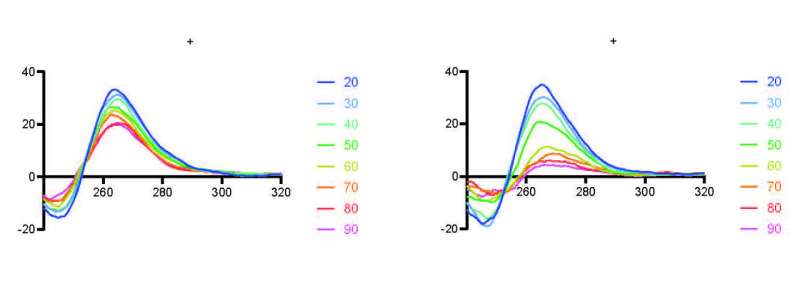Circular dichroism showing folding of RNA into G-quadruplexes at different temperatures. Credit: Luige et al. 2024
Researchers from Aarhus University and the Italian Institute of Technology have discovered how certain proteins can attach to special structures in RNA, called G-quadruplexes. Additionally, they have developed computational tools capable of predicting these protein-RNA interactions. The newfound ability to predict these interactions can help future work in understanding molecular pathways in the cell and pave the way for developing drugs targeting these RNA G-quadruplex binding proteins, that are found to be involved in disease such as cancer.
Proteins binding to RNA are important in many processes in the cell and can mediate a range of biological functions. A specialized structure in both DNA and RNA, the G-quadruplex, consists of regulatory elements involved in gene expression in both DNA and RNA.
In a new study, the researchers used theoretical predictions and molecular biology experiments to show that many chromatin-binding proteins bind to RNA G-quadruplexes. With this information, they can classify proteins based on their potential to bind RNA G-quadruplexes.
The study used a combination of experimental identification of RNA G-quadruplex-binding proteins and computational methods to build a prediction tool that identifies the probability that a protein binds to RNA G-quadruplexes. The findings showed that predicted proteins show a high degree of protein disorder and hydrophilicity, suggesting an involvement in both transcription and phase separation into membrane-less organelles.
Ulf Ørom's group has previously shown that RNA-DNA dual binding proteins are likely to have an involvement in the DNA damage response, linking DNA and RNA binding properties to a number of proteins. In the study, the researchers expanded the knowledge of RNA-binding proteins to identify RNA G-quadruplex binding proteins.
The researchers have also developed a computational tool to assess RNA G-quadruplex-binding potential of proteins.
With these new results, the researchers identify properties of protein-RNA interactions, and provide means to identify G-quadruplex binding properties that can potentially be targeted therapeutically in disease.
The findings have been published in Nature Communications.
More information: Johanna Luige et al, Predicting nuclear G-quadruplex RNA-binding proteins with roles in transcription and phase separation, Nature Communications (2024). DOI: 10.1038/s41467-024-46731-9
Computational tool: service.tartaglialab.com/updat … on/815419/dda3f5c513
Journal information: Nature Communications
Provided by Aarhus University
























